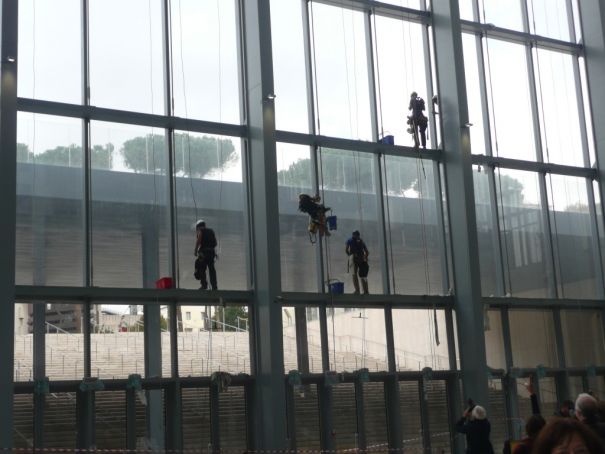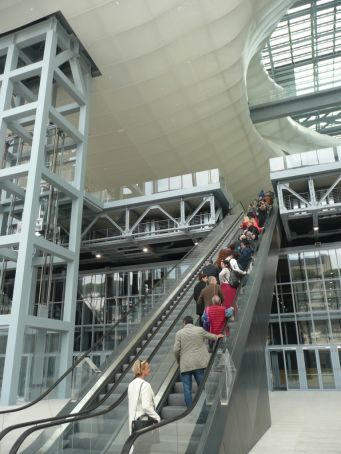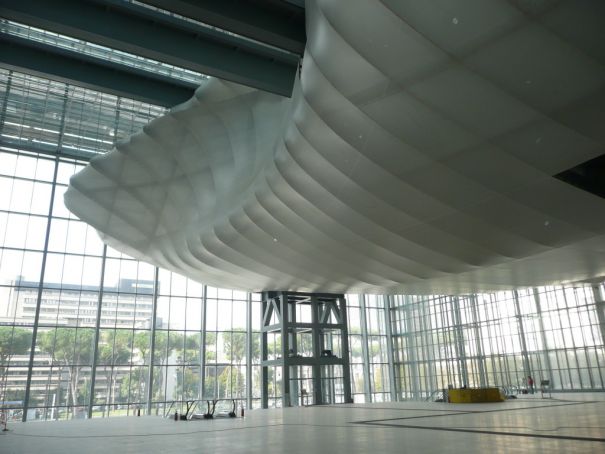Rome now has a futuristic new conference centre by Italian architect Massimilliano Fuksas.
Margaret Stenhouse
Sometimes miracles do happen – even in a city as beleaguered and beset with problems as Rome today. After a seemingly endless series of delays and setbacks stretching back to 2007, when the first corner stone was laid, Massimiliano Fuksas' revolutionary project for an international conference centre worthy of Italy’s capital city has now emerged from its chrysalis.
When Wanted in Rome spoke to the architect about the project in 2008, diggers were hard at work excavating the chosen site on Via Cristoforo Colombo near the EUR lake and completion was scheduled for the end of 2010. Fuksas was enthusiastic about his futuristic design. He said he had long dreamed of creating “a building that had no crystallised form at all….like a cloud being blown by a strong wind – a membrane inside a glass box that would seem to expand and would shine luminous at night.”
At that time, he had already spent seven years studying the project and drawn up over 6,500 preparatory drafts for the landmark building that he baptised – appropriately – the Nuvola or Cloud.
During the years that followed, it looked as if La Nuvola was going to remain a dream and passersby became resigned to seeing a desolate wasteland of empty scaffolding occupying the site beyond the Marconi Obelisk in EUR. Construction stagnated as costs spiralled, bureaucratic hiccups prevailed and the original partners got embroiled in in-house squabbles. The planned completion date came and went with only a skeleton to show. By this time, the Cloud was wallowing in debt and lagging far behind schedule.
Finally, in 2013, a government loan, coupled with the sale of property belonging to EUR Spa, the main project partner, allowed work to begin again in earnest. This time, the objective was to inaugurate the new conference centre to coincide with Expo 2015 in Milan. Given the precedents, a mere year’s delay before the actual inauguration, on 29 October 2016, seems virtually marginal.
EUR Spa, (90 per cent owned by the Italian ministry of finance and 10 per cent by the city of Rome) called in a super manager from Milan to speed things up. Enrico Pazzali, former managing director of Fiera Milano Spa (Milan Fair), joined the EUR Spa team in August 2015. Four months later, he became chief executive cfficer. He confesses he found that construction work was “far behind schedule”.
Pazzali diplomatically glosses over the reasons for all the delays, attributing them to “mainly mismanagement.” He is enthusiastic about Fuksas’ innovative design and its potential: “Fuksas isn’t just a superstar, he has given Rome this great opportunity. Rome has enormous potential as a convention destination but up till now the city hasn’t had the possibility of hosting major events.”
Fuksas’ dream now hangs suspended inside its enormous 40m-high glass showcase – an amorphous white form in fibreglass and silicone encased in a mesh of iron girders, only vaguely visible in daylight behind the reflection of the outside world on its wall of windows.
La Nuvola itself, however, is only a minor part of the entire encasing structure, known as La Teca (the Container). The stairs into the main entrance lead down into a vast 9,000 sqm plenary hall that can accommodate 6,000 delegates. When fully in use, the structure will be divided into flexible modules of various sizes, as required.
Energy conservation has also been an important element of the design. The Teca is roofed with solar panels and the entire building is equipped with a variable airflow conditioning system that protects the structure from overheating.
An escalator connects to the mezzanine floor, or “Gallery”, with private office space for business meetings and facilities like cloakrooms and a bar. Special Fuksas touches are reflected in the Guzzini lamps dangling from the ceiling (designed by the architect) and the various service wires, tubes and cables are deliberately left visible.
The main attraction is the mythical auditorium, La Nuvola itself, the “heart” of the building. The Cloud can accommodate an additional 1,700 delegates in addition to the 6,000 or so in the lower hall. From close up under its belly, on the next floor up, it looks solid rather than diaphanous, cradled within its complex metal ribcage. The skin is smooth and taut to the touch and measures 15,000 sqm and is made of 700 individual pieces.
However, there is nothing cloud-like about the interior. It’s a surprise to find the auditorium entirely lined with American red cherry wood panels. “This is necessary for the acoustics,” Pazzali explains, demonstrating that his voice carried clearly and effortlessly to the back of the room without the help of a microphone. “Sounds rebound from the wood and are projected throughout the entire hall.”
EUR Spa has been cautious about promoting the new convention centre. Now that it is safely and satisfactorily completed, however, feelers are going out.
“We are negotiating 15 events but it takes two or three years for a major international convention to be organised. We expect business to start in earnest around 2020.”
At the moment, the Nuvola (as Romans will no doubt continue to call it) has already secured its first major booking, beating Glasgow and Barcelona to host an international delegation of lawyers in 2018.
However, the third arm of the project still has to be completed. That is the Lama (or Blade), the rather oddly-named high-rise hotel of 441 rooms standing next door. Parking facilities – another essential feature – have already been taken care of, with underground space for 800 cars.
Pazzali hopes eventually to have 160 events a year, which would generate revenue, not only for the centre, but for the entire city: “Until now Rome has only been able to organise small events due to the lack of suitable space. Rome is a very attractive venue and now we shall be able to compete with cities like London and Paris.”
This article was published in the December edition of Wanted in Rome magazine.

























